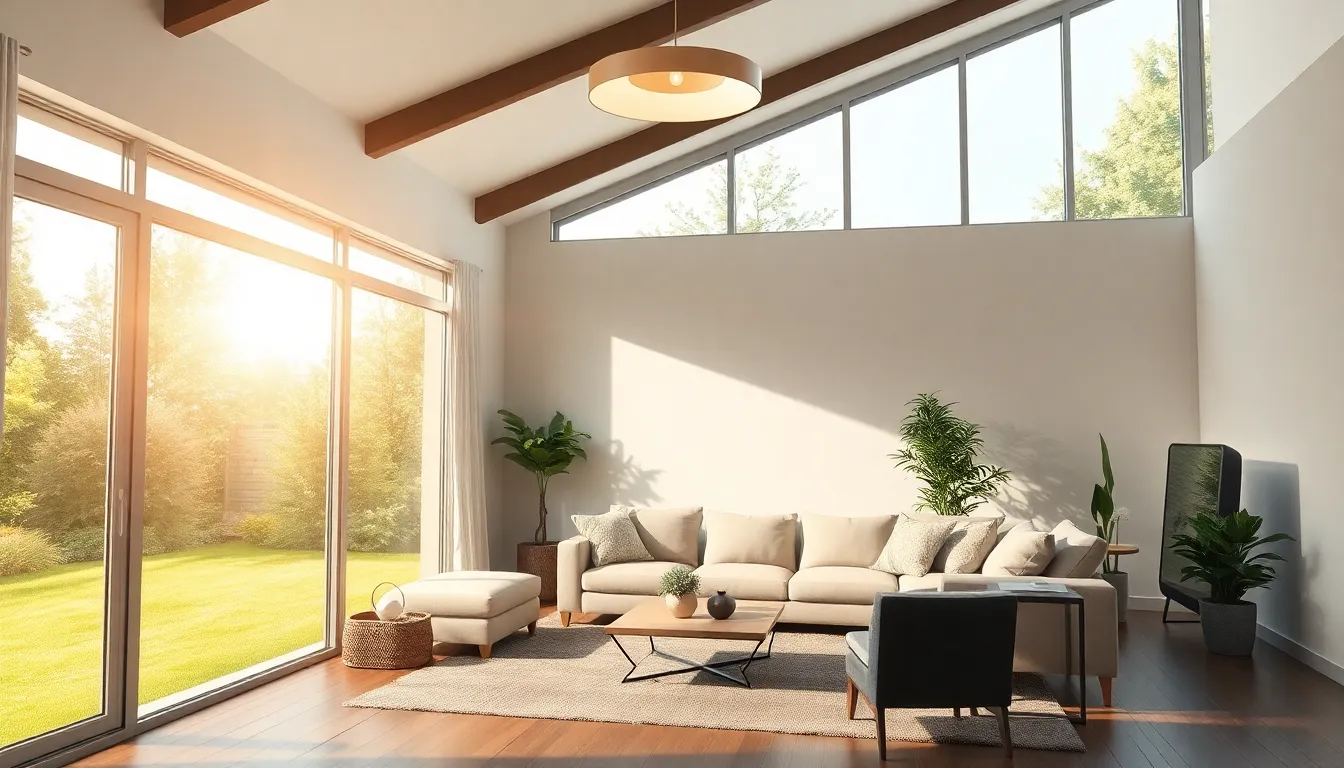In a world where energy bills creep higher than a cat on a hot tin roof, lighting efficiency is the unsung hero we all need. Imagine flicking a switch and not just illuminating your space but also saving a few bucks while you’re at it. Sounds like magic, right? Well, it’s not. It’s just smart lighting choices that can turn your home or office into a beacon of efficiency.
Table of Contents
ToggleWhat Is Lighting Efficiency
Lighting efficiency refers to the ability of a lighting system to convert electrical energy into visible light. It measures how effectively light illuminates a space while minimizing energy use.
Defining Lighting Efficiency
Defining lighting efficiency involves understanding lumens, watts, and the ratio between them. Lumens indicate the brightness produced, while watts represent energy consumption. Higher lumens per watt indicate more efficient lighting options. For instance, LED bulbs typically produce 80-100 lumens per watt, compared to incandescent bulbs that only achieve around 15 lumens per watt. This distinction highlights the significant difference in energy use and output.
Importance of Lighting Efficiency
Importance of lighting efficiency spans economic and environmental aspects. Efficient lighting reduces energy consumption, leading to substantial savings on energy bills. For example, switching from incandescent to LED bulbs can decrease lighting costs by 75%. Environmentally, lower energy use translates to reduced greenhouse gas emissions. Prioritizing lighting efficiency contributes to sustainable practices, making it a vital consideration for homes and businesses alike.
Factors Affecting Lighting Efficiency

Several factors significantly influence lighting efficiency. Understanding these elements helps optimize energy use and enhance performance.
Type of Lighting Technology
Different lighting technologies exhibit varying efficiency levels. LED bulbs produce up to 100 lumens per watt, making them a top choice. Incandescent bulbs, in contrast, typically generate only 10 to 17 lumens per watt, underscoring their inefficiency. Compact fluorescent lamps (CFLs) offer better performance than incandescents, delivering about 35 to 100 lumens per watt. Moreover, halogen bulbs provide 16 to 24 lumens per watt, but still lag behind LEDs. The selection of the right lighting technology strongly affects overall energy consumption.
Environmental Considerations
Environmental factors also play a crucial role in lighting efficiency. Ambient light levels impact how much artificial lighting is necessary. Adequate natural light can reduce reliance on electric lighting during the day. Additionally, the geographical location affects daylight availability and overall energy use. Light pollution from urban areas can disrupt both human circadian rhythms and local ecosystems. Incorporating energy-efficient designs and fixtures contributes to sustainability, lowering energy usage and minimizing ecological footprints.
Measuring Lighting Efficiency
Measuring lighting efficiency involves determining how effectively a lighting system converts electrical energy into visible light.
Common Metrics Used
Several metrics assess lighting efficiency, including lumens per watt. This metric indicates the amount of light produced for each watt consumed. Efficacy ratings signify how well different technologies perform, revealing LEDs can reach 100 lumens per watt, while incandescent bulbs often generate only 10 to 17 lumens per watt. Energy Efficiency Ratio (EER) provides another comparative measure for energy consumption across different bulb types. Color Rendering Index (CRI) also measures how accurately colors appear under a light source. Each metric offers valuable insights into selecting lighting solutions that optimize energy usage.
Tools and Techniques for Measurement
Various tools and techniques exist for measuring lighting efficiency. Light meters provide precise assessments of luminous intensity in an environment. These devices measure illuminance levels in lux or foot-candles, enabling comparisons between different lighting installation setups. Smart lighting software can analyze energy usage patterns and report on lumens per watt in real-time. Additionally, photometric testing allows for in-depth evaluations of specific fixtures’ performance. Each resource aids in making informed decisions about effective lighting design and efficient technology utilization.
Improving Lighting Efficiency
Improving lighting efficiency involves implementing specific strategies tailored to different environments. Both residential and commercial spaces can benefit from efficient lighting choices.
Strategies for Residential Spaces
Residents can achieve greater lighting efficiency by replacing incandescent bulbs with LED options, which provide up to 100 lumens per watt. Using dimmer switches allows control over light intensity, completing energy-saving goals. Natural light should be optimized by positioning mirrors strategically to enhance brightness during the day. Adopting smart lighting systems enables automation, allowing lights to turn off when not in use. Lastly, utilizing fixtures with higher reflectance can increase overall illumination without boosting wattage.
Strategies for Commercial Spaces
Businesses can enhance lighting efficiency by installing energy-efficient LED fixtures, cutting energy costs substantially. Employing daylight harvesting techniques can maximize natural sunlight while reducing reliance on artificial light. Regular maintenance of existing fixtures ensures they operate at peak efficiency, preventing loss of brightness due to dust buildup. Implementing occupancy sensors in less-frequented areas helps minimize energy waste. Choosing the right color temperature for specific tasks improves worker productivity, making the space more effective overall.
Future Trends in Lighting Efficiency
Emerging trends in lighting efficiency reflect a significant shift toward innovation and sustainability. New technologies aim to improve energy savings while enhancing user experience.
Advancements in Technology
Innovations in LED technology are shaping the future of lighting efficiency. Smart lighting systems incorporate sensors to adjust brightness based on occupancy and ambient light levels. Manufacturers are developing tunable white LEDs, allowing users to customize color temperature for various tasks. Additionally, integration with Internet of Things (IoT) devices supports remote control and energy monitoring. These advancements not only improve usability but also contribute to reduced energy consumption.
Sustainable Practices
Embracing sustainable practices becomes increasingly vital in lighting efficiency. Utilizing renewable energy sources, like solar power for outdoor lighting, significantly decreases reliance on traditional power grids. Companies are adopting sustainable manufacturing processes, minimizing waste and environmental impact. Incorporating eco-friendly materials in fixtures further enhances sustainability. Organizations that invest in energy management systems optimize lighting usage, leading to substantial cost savings. The commitment to sustainability drives innovation in lighting, making it essential for future developments.
Lighting efficiency plays a pivotal role in creating sustainable environments while reducing energy costs. By opting for LED technology and implementing smart lighting solutions, individuals and organizations can significantly enhance their energy savings. The shift towards more efficient lighting not only benefits the wallet but also contributes to a healthier planet.
As advancements continue in lighting technology, staying informed and adapting to these changes will be essential for maximizing efficiency. Embracing innovative solutions and sustainable practices will ensure a brighter future for both homes and businesses.





